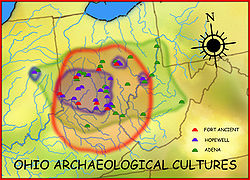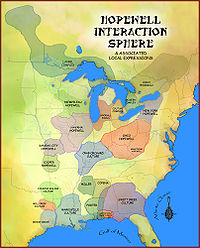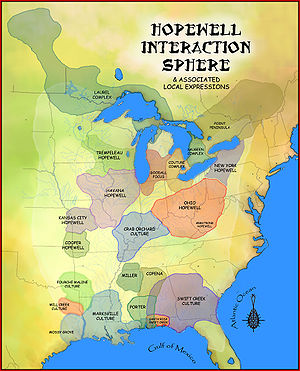- Woodland period
-
The Woodland period of North American pre-Columbian cultures was from roughly 1000 BCE to 1000 CE in the eastern part of North America. The term "Woodland Period" was introduced in the 1930s as a generic header for prehistoric sites falling between the Archaic hunter-gatherers and the agriculturalist Mississippian cultures. The Eastern Woodlands cultural region covers what is now eastern Canada south of the Subarctic region, the eastern United States, along to the Gulf of Mexico.[1]
This period is considered a developmental stage without any massive changes in a short time but instead having a continuous development in stone and bone tools, leather crafting, textile manufacture, cultivation, and shelter construction. Many Woodland peoples used spears and atlatls until the end of the period, when they were replaced by bows and arrows; however, Southeastern Woodland peoples also used blowguns.
The major technological advancement during this period was the widespread use of pottery (which had begun in the late Archaic period) and the increasing sophistication of its forms and decoration. The increasing use of agriculture and the development of the Eastern Agricultural Complex also meant that the nomadic nature of many of the groups was supplanted by permanently occupied villages, although intensive agriculture did not really begin until the succeeding Mississippian period.
Contents
Early Woodland period (1000–1 BCE)
A period historically using the introduction of pottery as a demarcation of the Woodland period, first believed to have occurred around 1000 BCE.
By the mid-1960s, however, it was evident that in some areas of the United States prehistoric cultural groups with a clearly Archaic cultural assemblage were making pottery without any evidence of the cultivation of domesticated crops. In fact, it appears that hunting and gathering continued as the basic subsistence economy and that true agriculture did not occur in much of the Southeast for a couple of thousand years after the introduction of pottery. This research indicated that a fiber-tempered horizon of ceramics greatly predates 1000 BCE, first appearing about 2500 BCE in parts of Florida with the Orange tradition and in Georgia with the Stallings culture.[2] Nevertheless, these early sites were typical Archaic settlements, differing only in the use of basic ceramic technology. As such, researchers are now redefining the period to begin with not only pottery, but the appearance of permanent settlements, elaborate burial practices, intensive collection and/or horticulture of starchy seed plants (see Eastern Agricultural Complex), differentiation in social organization, and specialized activities, among other factors. Most of these are evident in the Southeastern United States by 1000 BCE. The Adena culture is the best-known early Woodland culture.
In some areas, like South Carolina and coastal Georgia, Deptford culture pottery persists until circa 700 CE. Most settlements are near the coast, often near salt marshes. Acorns and palm berries were eaten, as well as wild grapes and persimmon. The most common prey was white-tailed deer. Shellfish formed an important part of the diet, and numerous coastal middens are known. After 100 BCE, burial mounds were built, which is taken to indicate social change.[3]
Middle Woodland period (1–500 CE)
The beginning of the Middle Woodland saw a shift of settlement to the Interior. As the Woodland period progressed, local and inter-regional trade of exotic materials greatly increased to the point where a trade network covered most of the Eastern United States. Throughout the Southeast and north of the Ohio River, burial mounds of important people were very elaborate and contained a variety of mortuary gifts, many of which were not local. The most archaeologically certifiable sites of burial during this time were in Illinois and Ohio. These have come to be known as the Hopewell tradition. Due to the similarity of earthworks and burial goods, researchers assume a common body of religious practice and cultural interaction existed throughout the entire region (referred to as the "Hopewellian Interaction Sphere"). Such similarities could also be the result of reciprocal trade, obligations, or both between local clans that controlled specific territories. Access to food or resources outside a clan's territory would be made possible through formal agreements with neighbors. Clan heads would then be buried along with goods received from their trading partners to symbolize the relationships they had established. Under this scenario, permanent settlements would be likely to develop, leading to increased agricultural production and a population increase.
Ceramics during this time were thinner and better quality than earlier times. Examples also show pottery also was more decorated than Early Woodland. One style was the Trempealeau phase which could have been seen by the Hopewell in Indiana. This type included a round body, and lines of decoration with cross-etching on rim. The Havana style found in Illinois had a decorated neck. One of the major tools unique to this era was Snyders Points. These were quite large and corner-notched. They were made by soft-hammering percussion, and finished by pressure flaking. [4]
Although many of the Middle Woodland cultures are called "Hopewellian," and groups shared ceremonial practices, archeologists have identified the development of distinctly separate cultures during the Middle Woodland period. Examples include the Armstrong culture, Copena culture, Crab Orchard culture, Fourche Maline culture, the Goodall Focus, the Havana Hopewell culture, the Kansas City Hopewell, the Marksville culture, and the Swift Creek culture.
The Center for American Archeology specializes in Middle Woodland culture.
Late Woodland period (500–1000 CE)
The late Woodland period was a time of apparent population dispersal, although populations do not appear to have decreased. In most areas construction of burial mounds decreased drastically, as well as long-distance trade in exotic materials. At the same time, bow and arrow technology gradually overtook the use of the spear and atlatl, and agricultural production of the "Three Sisters" (maize, beans, and squash) was introduced. While full scale intensive agriculture did not begin until the following Mississippian period, the beginning of serious cultivation greatly supplemented the gathering of plants.
Late Woodland settlements became more numerous, but the size of each one (with exceptions) was smaller than their middle Woodland counterparts. The reasons for this are unknown, but it has been theorized that populations increased so much that trade alone could no longer support the communities and some clans resorted to raiding others for resources. Alternatively, the efficiency of bows and arrows in hunting may have decimated the large game animals, forcing the tribes to break apart into smaller clans to better use local resources, thus limiting the trade potential of each group. A third possibility is a colder climate may have affected food yields, possibly affected by Northern Hemisphere extreme weather events of 535–536, also limiting trade possibilities. Lastly, it may be that agricultural technology became sophisticated enough that crop variation between clans lessened, thereby decreasing the need for trade.
As communities became more isolated, they began to develop in their own unique ways, giving rise to small-scale cultures that were distinctive to their regional areas. Examples include the Baytown, Troyville and Coles Creek cultures of Louisiana, the Alachua and Weeden Island cultures of Florida, and the Plum Bayou culture of Arkansas and Missouri.
Although the 1000 CE ending of the Late Woodland period is traditional, in practice many regions of the Eastern Woodlands adopted the full Mississippian culture much later than that. Some groups in the north and northeast of the current United States, such as the Iroquois, retained a way of life that was technologically identical to the Late Woodland until the arrival of Europeans. Furthermore, despite the widespread adoption of the bow and arrow during this time, the peoples of a few areas of the United States appear never to have made the change. During Hernando de Soto's travels through the southern United States around 1543, the groups at the mouth of the Mississippi river still preferentially used the spear.
See also
- Glenwood culture
- Rock Eagle Effigy Mound
- Rock Hawk Effigy Mound
- Old Stone Fort (Tennessee)
- Pinson Mounds
- The Bluff Point Stoneworks
- Mound builder (people)
Notes
- ^ "Eastern Woodland Indians Culture". Native Art in Canada.
- ^ Kenneth E. Sassaman (2002). David G. Anderson and Robert C. Mainfort Jr. ed. The Woodland Southeast. University of Alabama Press. ISBN 0-81731137-8.
- ^ Milanich 1994:111-41
- ^ Behm, Jeffrey (2007 March) Middle Woodland. University of Wisconsin-Oshkosh. Oshkosh, WI
References
- Bense, Judith A. (1994). Archaeology of the Southeastern United States: Paleoindian to World War I. New York: Academic Press. ISBN 0-12-089060-7.
- Milanich, Jerald T. (1994). Archaeology of Precolumbian Florida. University Press of Florida. ISBN 0-8130-1273-2.
- National Park Service, Southeast Archaeological Center. "The Woodland Period". http://www.cr.nps.gov/seac/woodland.htm. Retrieved August 6, 2009.
List of Adena culture sites · Woodland period · Mound builder (people) · List of archaeological periods (North America)Ohio Sites Adena Mound · Austin Brown Mound · Arledge Mounds I and II · Beam Farm · Clemmons Mound · Conrad Mound Archeological Site · Coon Hunters Mound · George Deffenbaugh Mound · Enon Mound · Fortner Mounds · Great Mound · Highbanks Metropolitan Park Mounds I and II · Hillside Haven Mound · Hodgen's Cemetery Mound · Horn Mound · Hurley Mound · Jackson Mound · Karshner Mound · Kinzer Mound · Luthor List Mound · Miamisburg Mound · Odd Fellows' Cemetery Mound · Old Maid's Orchard Mound · Orators Mound · Carl Potter Mound · Reeves Mound · D.S. Rose Mound · Ross Trails Adena Circle · Short Woods Park Mound · Snead Mound · Spruce Run Earthworks · David Stitt Mound · Story Mound (Cincinnati) · Story Mound (Chillicothe) · Wolf Plains Group · Zaleski Mound Group
Kentucky Sites West Virginia Sites Indiana Sites Related topics · Ancient Monuments of the Mississippi Valley · burial mound · Eastern Agricultural Complex · Hopewell tradition Hopewellian peoplesWoodland period · List of Hopewell sites · Mound builder (people) · List of archaeological periods (North America)
Hopewellian peoplesWoodland period · List of Hopewell sites · Mound builder (people) · List of archaeological periods (North America)Ohio Hopewell Beam Farm · Benham Mound · Cary Village Site · Cedar-Bank Works · Dunns Pond Mound · Ellis Mounds · Ety Enclosure · Ety Habitation Site · Fort Ancient · Fortified Hill Works · Great Hopewell Road · High Banks Works · Hopeton Earthworks · Hopewell Culture National Historical Park · Indian Mound Cemetery · Keiter Mound · Marietta Earthworks · Moorehead Circle · Mound of Pipes · Nettle Lake Mound Group · Newark Earthworks · Oak Mounds · Perin Village Site · Portsmouth Earthworks · Seip Earthworks and Dill Mounds District · Shawnee Lookout · Tremper Mound and Works · Williamson Mound Archeological District
Crab Orchard culture Goodall Focus Havana Hopewell culture Kansas City Hopewell Marksville culture Miller culture Point Peninsula Complex Swift Creek culture Etowah Indian Mounds · Leake Mounds · Kolomoki Mounds Historic Park · Miner's Creek site, · Nacoochee Mound · Swift Creek mound site · Yearwood siteOther Hopewellian peoples Armstrong culture · Copena culture · Fourche Maline culture · Laurel Complex · Saugeen Complex · Old Stone Fort (Tennessee)Exotic trade items Related topics · Ancient Monuments of the Mississippi Valley · Black drink · burial mound · Calumet (pipe) · Effigy mound · Hopewell pottery · Horned Serpent · Eastern Agricultural Complex · Underwater panther Coles Creek and Plum Bayou cultures
Coles Creek and Plum Bayou culturesColes Creek sites Aden Site · Balmoral Mounds · Churupa Plantation Mound · Coles Creek Site · Crippen Point site · Cypress Grove Mound · DePrato Mounds · Greenhouse Site · Filhiol Mound Site · Fisher Site · Flowery Mound · Frogmore Mound Site · Ghost Site Mounds · Greenhouse Site · Insley Mounds · Kings Crossing Site · Lamarque Landing Mound · Marsden Mounds · Mazique Archeological Site · Mott Mounds · Mound Plantation · Peck Mounds · Raffman Site · Scott Place Mounds · Shackleford Church Mounds · Sundown Mounds · Transylvania Mounds · Troyville Earthworks · Venable Mound · Wade Landing Mound ·Coastal Coles Creek sites Atchafalaya Basin Mounds (16SMY10) · Bayou Black Mound (16TR78) · Bayou Cypremont (16SMY7) · Bayou Grande Cheniere Mounds · Bayou L’Ours Site · Bayou Portage Mounds · Bayou Sorrel Mounds (16IV4) · Clovelly Site (16LF64) · Cypress Point Site (16VM112) · Eagle Point Site (16IB123) · Gibson Mounds (16TR5) · Greenwood Cemetery Site (16SMY10) · Kleinpeter Mounds · Little Cheniere Site (16CM22) · Little Pecan Island Site (16CM43) · Jerry Haas Site (16SJ51) · Machias Lake (16SB2) · Morgan Mounds (16VM9) · Pecan Mounds (16SM37) · Pennison Mounds (16AS16) · Portage Mounds (16SM5) · Richeau Field Site (16TR82) · Schwing Place Mound (16IV13) · Southwest of Cut Off Lagoon (16SB50) · St. Gabriel Mounds (16IV128) · Temple Mounds Site (16LF4) ·Plum Bayou sites Chandler Landing Site · Coy Site (3LN20) · Dogtown Site · Hayes Site (35CS196) · Maberry Site · Roland Site (3AR30) · Toltec Mounds ·Related topics · Eastern Agricultural Complex · Fourche Maline culture · Mississippian culture · Natchez · Plaquemine culture · Platform mound · Taensa · Troyville culture · Late Woodland cultures
Late Woodland culturesSites Baytown Site · Beattie Park Mound Group · Book Site · Bowen Site (12 MA 61) · Brinsfield I Site · Brokaw Site · Clampitt Site (12-LR-329) · Fisher Site · Hoye Site · Little Maquoketa River Mounds State Preserve · Memorial Park Site · Mott Mounds · Nottingham Site · Ormond Mound · Sommerheim Park · Troyville Earthworks · University of Tennessee Agriculture Farm Mound ·Cultures Alachua culture · Baytown culture · Clemson Island culture · Coles Creek culture · Manahoac · Monongahela culture · Oliver Phase · Plum Bayou culture · Springwells Phase · Troyville culture · Weeden Island culture ·Related topics · Steuben point · Belle Glade culture · Extreme weather events of 535–536 · Fort Ancient culture · Mississippian culture · Oneota · St. Johns culture ·Categories:- Woodland period of North America
- Adena culture
- Archaeological cultures of North America
- Pre-Columbian cultures
- Late Prehistoric period of North America
- Periods and stages in archaeology
- Native American history
Wikimedia Foundation. 2010.



